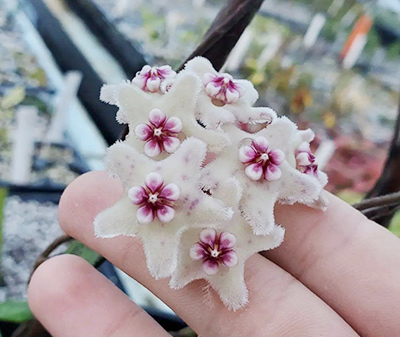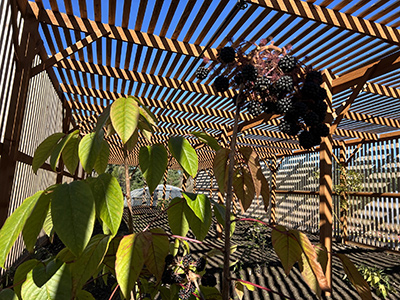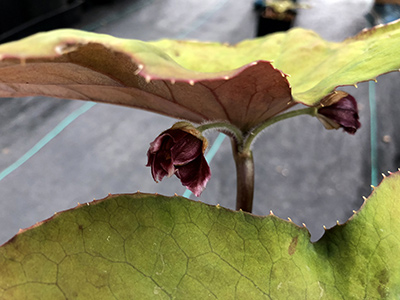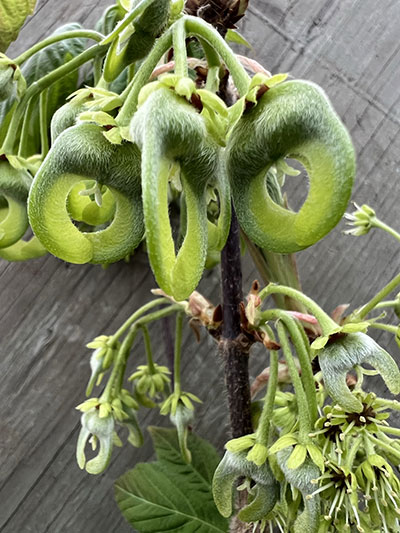The Rare Plant Rumble
And the winner is!!!
Agapetes smithiana APA 022 Picotee Calyx

Agapetes smithiana APA 022 Picotee Calyx is one that has honed its craft in the development league here for quite a few years after growing on from a bunch of wild-origin seedlings shared with us by plant legend Steve Hootman. The "smiths" are a talented group, with the worst of them easily being the best in other species. This is an epiphytic species with edible fruit closely related to Vaccinium – blueberries, The yellow flowers in this form have an extra large calyx that sports an alluring dark eyeliner margin that really elevates its game. These are blooming now and in the wild, grow in the trees of the temperate Himalayan cloud forests, where they literally play above the rim.
About the Rare Plant Rumble
The Rare Plant Rumble is a tournament bracket pitting individual rare plants against each other. The public votes to see who will advance each round. Voting takes place on our website in March. Anyone may vote based on any criteria they like, but only one plant will triumph as the Verdant Victor.
Why are these plants important?
Our Conservancy plants are rare, vulnerable, and threatened by climate change, resource exploitation, and other factors. One of our driving goals is to ensure that these important genetic resources are conserved, and that is done by maintaining a reference collection at FRBC while distributing appropriate plants to various botanical entities in North America.
Meet the 2022 Contenders
.-MD17-83-(1).jpg)

Hoya lyi is a ringer in the game for sure. A scrabbling, subtropical vine from southern China, Vietnam and Laos, whose unremarkable stiff, thick green leaves, would make you think "Benchwarmer" for sure. However, this grew as an epiphyte along with hotshots Aeschynanthus, Polygonatum mengtzense and fantastic ferns so we figured if these starters were good with letting it hang with them, maybe this little Hoya is just waiting for that clutch moment to bring its game. It took some years, but its first flowering had us high-fiving and hell-yeahing the nothing-but-net debut of Hoya 'No Lie' lyi!
Aralia wangshanensis H2MD 104
.jpg)

Until recently, this rare talent was known as Pentapanax henryi, honoring the legendary Irish plant hunter, Augustine Henry. Whatever the name, this a multiseason crowd pleaser that always brings its ‘A’ game. A big deciduous shrub whose large pinnate leaves sets an imposing screen, it catches fire in autumn, by turning yellow, red and burgundy. Umbels of white flowers are tightly covered by various hornet species for the lipid-rich pollen, ensuring a full-court press of black shiny fruit. Tired of your tender araliads going down in the first round with winter injuries? This talented Aralia has what it takes to go deep in the playoffs and maybe, just maybe, cut down the net.
Podophyllum/Dysosma difforme YuGu 424 is the floor general, the cerebral player, that brings a consistent excellence into play. In a class all its own, this subtle yet grand perennial powerhouse is in that indispensable genus (we gave you two genera so you don't have to immediately change the names on your jerseys from Podophyllum to Dysosma) of arguably the most dramatic temperate woodland perennials on the planet. This is a fresh new draft pick and once it learns the game, look out!
Podophyllum/Dysosma difforme YuGu 424

Paris chinensis CDHM 14652

Paris chinensis CDHM 14652 is in an unequivocal All-Star genus and the larger species like this one are unstoppable power forwards on the plant-lust-o-meter. Once they increase, a single plant of this has trade value worth several garden players along with future plant picks. This played for many years here under an unlikely pseudonym from the original seed collection. On the trail, one of our plant hunting mates had to bail off-trail for a call of nature and returned with a few ripe orange fruits of a Paris which was offered to us. We inquired if there were any guesses as to species and there was: “Crapiana probably".
Acer sterculiaceum subsp. franchettii CDHM 14052 was literally born to play hoops as the developing samaras show. This distinctive and choice maple is a multiple position player with attractive new growth, attractive greenish-yellow flowers, attractive fruit, attractive mature leaves and attractive golds for fall color. Like the coach says, if it's working, don't change it!
Acer sterculiaceum. subsp. Franchettii


Fordiophyton sp. YuGu
.jpg)
.jpg)
This Fordiophyton is an imposing specimen in a fascinating genus of warm-temperate to cool subtropical Asian groundcovers. We have been glamored by this genus every time we have encountered it for its peerless play, its seamless integration into the flow, its intuitive ability to get the most out of every situation it faces and how it elevates every plant around it. One of the finest groundcovers we have ever seen, this plays a smothering defense without fouling. We have revered this for years without seeing a flower until last year when it did the impossible - took its game to the next level, burying 3's from the logo with gorgeous pink flowers! We might have to call it Fordiophyton 'Caitlin'.
The deciduous small tree Photinia beauverdiana is a loose-limbed, sinuously-agile presence in the post and anchors its spot in the garden with the right supporting players. White flowers are followed by showy clusters of orange-red fruit which hold their position long enough to match up against the autumnal yellow of the leaves for a slam-dunk combination. Kelly was collecting this for a friend, standing on a sloped mossy rock face, stretching to collect a fruit when his feet went out from under him. Being a good plant hunter, he held the fruit safely aloft rather than using his hand to break his fall, and fractured a rib. This has recently switched teams to a new genus and species and is now Pourthiaea arguta, but Kelly will forever trash-talk this graceful sky-hooker as "That phucking Photinia."
Photinia beauvardiana
.jpg)
Agapetes smithiana APA 022 Picotee Calyx

Agapetes smithiana APA 022 Picotee Calyx is one that has honed its craft in the development league here for quite a few years after growing on from a bunch of wild-origin seedlings shared with us by plant legend Steve Hootman. The "smiths" are a talented group, with the worst of them easily being the best in other species. This is an epiphytic species with edible fruit closely related to Vaccinium – blueberries, The yellow flowers in this form have an extra large calyx that sports an alluring dark eyeliner margin that really elevates its game. These are blooming now and in the wild, grow in the trees of the temperate Himalayan cloud forests, where they literally play above the rim.
Why are these plants important?
Our Conservancy plants are rare, vulnerable, and threatened by climate change, resource exploitation, and other factors. One of our driving goals is to ensure that these important genetic resources are conserved, and that is done by maintaining a reference collection at FRBC while distributing appropriate plants to various botanical entities in North America.
We also actively propagate plants in the collection so they may be offered to gardeners. There is much knowledge to be gained from the home gardener on how plants adapt and perform in the extremely diverse growing conditions of North America.
We are a 501(c) (3) nonprofit that relies on donations to do this important conservation work. Please consider donating today and becoming a member of the FRBC.
What happens to the winning plant?
The winning plant will get bragging rights for an entire year, the FRBC Facebook will make the plant image our banner photo, and it will be featured in a video on social media.



